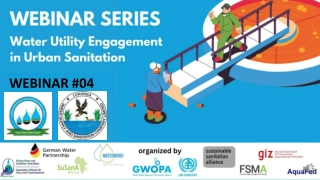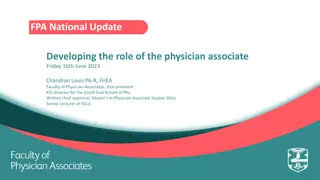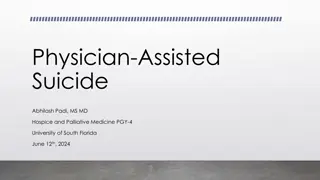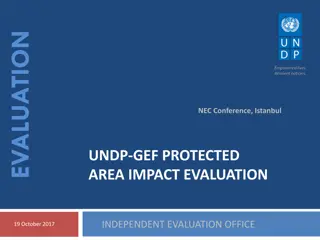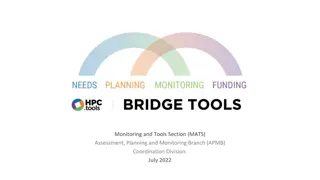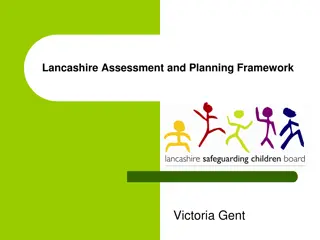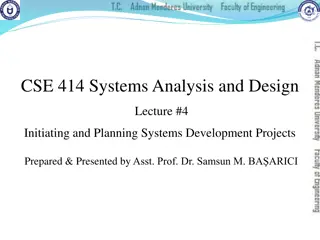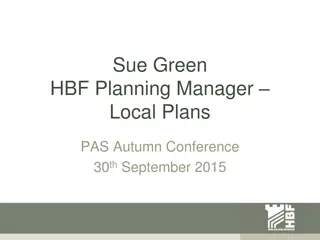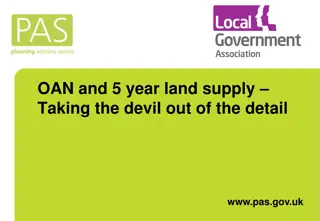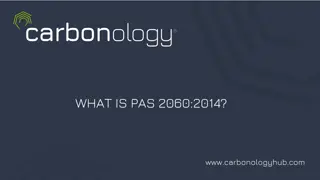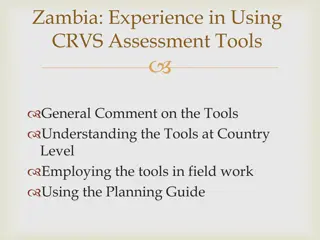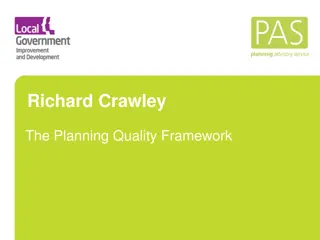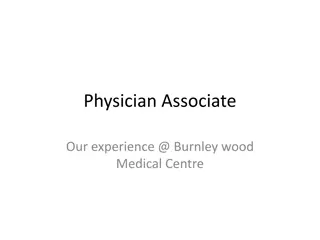PAS Project IFSM Tools for Citywide Assessment and Planning
This project focuses on providing tools and support for citywide assessment and planning in the areas of water supply, sewerage, septage, and drainage. Through data collection and field assessments, stakeholders can make informed decisions to improve urban sanitation and infrastructure.
Download Presentation

Please find below an Image/Link to download the presentation.
The content on the website is provided AS IS for your information and personal use only. It may not be sold, licensed, or shared on other websites without obtaining consent from the author.If you encounter any issues during the download, it is possible that the publisher has removed the file from their server.
You are allowed to download the files provided on this website for personal or commercial use, subject to the condition that they are used lawfully. All files are the property of their respective owners.
The content on the website is provided AS IS for your information and personal use only. It may not be sold, licensed, or shared on other websites without obtaining consent from the author.
E N D
Presentation Transcript
1 PAS Project IFSM Tools For Citywide Assessment and Planning - Aasim Mansuri and Dhruv Bhavsar AMRUT TRAINING PROGRAMME (Capsule-2) ON MANAGEMENT OF WATER SUPPLY, SEWERAGE, SEPTAGE AND DRAINAGE IN URBAN LOCAL BODIES 7th December, 2016 CEPT University, Ahmedabad
PAS Journey from 2009 2009 416 Cities 68 Million population 167 Cities of Gujarat 249 Cities of Maharashtra continued for 6 years 2015 463 Cities 72.8 Million population 168 Cities of Gujarat 259 Cities of Maharashtra 43 Cities of Chhattisgarh 2016 769 Cities 88 Million population 168 Cities of Gujarat 364 Cities of Maharashtra 168 Cities of Chhattisgarh 69 Cities of Telangana Forth coming 323 Cities, 23 Million population 96 Cities of Assam 43 Cities of Jharkhand 184 Cities of Rajasthan www.pas.org.in D:\PAS YA DUR 2\PAS Logo.png 2
Sanitation Activities under PAS Project Work at city levels From planning to implementation support Sanitation Planning tools PIP CSP ODF FSM Performance improvement plans City Sanitation Plans Open Defecation Free Plans Fecal Sludge Management Plans Supporting Statewide Program - Maharashtra PSP in IFSM Capacity building programmes State level guidelines for ODF , IFSM ODF Documentation support Monitoring SBM framework Onsite sanitation Sanitation Finance ? Capacity building of cities and local contractors Sanitation Credit City Sanitation Fund Demand assessment Supply side study of FIs FSM guidelines SanBenchmarks D:\PAS YA DUR 2\PAS Logo.png
AMRUT Mission The National Priority is to create infrastructure o To provide basic services to households, and o build amenities to improve quality of life Focus on measurable urban service delivery outcomes Service Delivery Focus on infrastructure that leads to delivery of services to citizens. Key purpose is to cover all households with water supply and sewerage (including septage) Service Level Benchmark framework: Basis to measure service delivery outcomes
Objective of the tool . . . Main objective of tools for Citywide assessment and planning is to help users identify key areas of assessment for commencing IFSM planning in city facilitated by SANIPLAN model and tools for data collection and field assessment which will help making informed discussion among stakeholders and provide for evidence-based decision making by city authorities
Module 1 : Assessing Service Performance Across the Full Service Chain Assessing service performance across the service chain through a city level assessment is the first step in planning process. It is an important exercise, which provides an initial sense of the state of FSM in the city, help in understanding the context and identifying gaps in key services. The data collection and field assessments in the city should start with a kick-off meeting with key stakeholders.
Module 1 : Assessing service performance across the full service chain Assessment through City level Performance Indicators Assessment across each link in the service chain Summary and vision
Citywide Sanitation assessment through Indicators - SAN Benchmarks Citywide Sanitation Indicators (Sewerage system + Onsite systems) 1. Coverage of toilets Percentage of properties with access to toilet facility in the city Percentage of households with individual or group toilets connected with adequate sanitation systems (sewer network/ septic tank / double pit system) to total households in the city. 2. Coverage of adequate sanitation system 3. Collection efficiency of sanitation system Weighted average of collection efficiency of each sanitation system, weighted by share of households dependent on each sanitation system. 4. Adequacy of treatment capacity of sanitation system Weighted average of adequacy of treatment plant capacity available for each sanitation system, weighted by share of households dependent on each sanitation system. 5. Quality of treatment of sanitation system Weighted average of quality of treatment of each sanitation system, weighted by share of households dependent on each sanitation system. Weighted average of extent of reuse of treated wastewater and sludge after adequate treatment as a percentage of wastewater and sludge received at the treatment plant, weighted by share of household dependent on each sanitation system. 6. Extent of reuse and recycling in sanitation system
Identify gaps across the sanitation value chain (1/2) Access Collection Conveyance Treatment Disposal/Reuse Method of collection of waste1 (Number of HH) Methods of conveyance of waste (Number of HH) Treatment of wastewater (in MLD) Disposal of waste (in MLD) Access to type of sanitation (Number of HH) 7,580 2% 5,145 7,580 8% 3.92 3.92 Others2 Open No 10% 4% defecation drains Pit 30% Community toilets latrines Open drains 57% Untreated wastewater Disposed into the river 100% 100% Septic tanks 86% Individual toilets 68% Closed drains 35% ~600 HH have no drains for conveyance of wastewater Only ~2% of septic tanks are cleaned per year ~ 135 HH practice OD in City X ~2,300 HH are dependent on community toilets 29% of non-slum HHs are also dependent on community toilets ~3.9 MLD of waste water is untreated No treatment facility for fecal sludge ~3.9 MLD of wastewater is dumped into river Krishna Fecal waste is dumped into the open ~500 HH with access to individual toilets depend on primitive methods of collection of waste Septic tanks are over sized and some lack access manhole covers Note: (1) Collection only for HH with individual toilets, (2) Includes low quality sewerage network and primitive methods such as latrines serviced by animals Source: Adapted from:, City Sanitation Plan of Wai , PAS Project CEPT University
Identify gaps using a wastewater flow diagram (2/2) Reuse/ disposal Treatment Conveyance Containment Emptying WC to Sewer (0%) Grey Water (80%) (Bathroom/ Kitchen) Conveyed through Drains Greywater Existing Situation No treatment Effluent WC to Septic tank (17.7%) Leakage Safely emptied Illegally dumped 1.9% Never emptied PIT Safely abandoned when full Latrines (1.9%) 1.9% Open defecation (0.4%) 6.3% 91.1% 0.15% 0.4% Domestic environment 0.15% Water Bodies Solid waste dumped site Ground Water 98.2%
Vision: Developing vision for end-to-end IFSM Plan (1/2) Disposal / Reuse Access Collection Conveyance Treatment Pour flush toilets Suction emptier truck No treatment facility Disposed off on dumping site Septic tanks Situation Current Septic tanks lack manhole covers Lack of universal access to improved toilets Only 2-4 % of septic tanks cleaned annually No facility for fecal sludge treatment Septage disposed off on dumping site without treatment Septic tanks are not of standard size Lack of adequate data base on toilets for properties No database on septic tanks for properties Pour flush toilets Treatment facility Revenue from compost Suction emptier trucks Septic tanks Providing access manhole covers to allow regular cleaning Preparing a schedule for period cleaning of septic tanks, to ensure that all septic tank are cleaned at least once in 3 years Installing treatment facility for the treatment of septage Safe dumping of treated fecal matter and/or the sale of septage at a fixed rate to nearby farms or agro-businesses Converting unimproved toilets to improved toilets Enforcing regulations on septic tanks design Vision Ensuring 100% access to improved toilets Enforcing regulations and penalties for periodicity of septic tank cleaning and safe handling of sludge Data base of properties with septic tanks Data base on toilets for all properties Payment using local taxes using escrow mechanisms
Vision:Developing vision for end-to-end IFSM Plan (2/2) Reuse/ disposal Treatment Conveyance Containment Emptying WC to Sewer (0%) 99.6% Grey Water (80%) (Bathroom/ Kitchen) Proposed Situation Reuse in agriculture Conveyed through settled sewer 50 % Greywater (80 %) Effective treatment (STP) 42.9% waterbodies Effluent (12.9 %) WC to Septic tank (20%) Leakage Septage treatment facility Safely emptied Reuse as compost Septage (6.7 %) 6.7% Never emptied PIT Latrines (0%) Open defecation (0%) 0.2% 0.2% Remains in septic tank Ground Water 0.4%
Module 1 : Tools TOOLS available for ASSESSING service PERFORMANCE across the service chain
Module 2: Enabling Environment: Policy, Regulation and Institutions It is important to understand and assess the prevailingenabling and regulatory environment as well as capacity of local stakeholders to manage the citywide FSM services. This can be assessed by a review of: a) State/national policies and guidelines on FSM, b) Regulatory framework for treatment, disposal, and reuse of fecal matter, and c) assessing roles and responsibilities of local government for FSM.
Module 2 : Enabling Environment: Policy, Regulation and Institutions National and state policy and guidelines on FSM Regulatory regime for FSM and the institutional roles Assessing local capacity for FSM
Assessing local capacity for FSM Understand the governance and institutional mechanism of the local government (or the agency responsible for FSM), and review of city wide plans, if any; especially those related to sanitation Assess the organizational structure and responsibilities related to septage management in the agency Review of outsourcing contracts and its management Capacity assessment of local government and gaps for IFSM e.g. developing contracts and monitoring mechanisms
Example: Local Government can make regulations/bye-laws for effective implementation of IFSM plan Resolution for undertaking IFSM in City X In case of lack of adequate policies and design standards for onsite sanitation, Local government needs to formulate bye-laws and rules for management of septage in following broad areas: Septic tank design and methods of approval of building plans to comply with rules: to ensure septic tanks of standard size are installed in new constructions Periodicity of de-sludging: to ensure septic tanks are cleaned every 3 years De- sludging procedures: to ensure safe handling of fecal sludge Sanitation tax: to persuade households to clean septic tanks regularly Resolution for Sanitation taxation for IFSM in City X Penalties: to deter irregular cleaning and use of substandard septic tanks Licensing and reporting of private players: to empanel private service providers for septic tank emptying services and O&M of treatment plant through , integrated contracts Monitoring: There is also a need for regular monitoring and inspection of septic tanks and de-sludging procedures to facilitate the implementation of bye-laws Awareness Generation activities
Module 2 : Tools TOOLS available for ASSESSING policies, REGULATIONS and CAPACITY of Local government
Module 3: Technology options for FSM services In designing a citywide IFSM service, it is important to assess technology options for each link in the service chain. This ranges from appropriate toilets and onsite systems such as septic tanks to conveyance as well as treatment and reuse. Toilets and Septic tanks Treatment technologies Emptying services Sludge drying bed Twin pit Conventional Vacuum Tanker Mini-Vacuum Tanker (Vacutug) Co-composting Bio-digestor toilet
Module 3 : Technology options for FSM services Assessing technical options for toilets and septic tanks Assessing options for emptying services and conveyance Assessing options for treatment and reuse of fecal sludge/septage
Assessing options for emptying services and conveyance Example When the Septic tank is Full . In India: the Central Public Health Engineering and Environmental Organization (CPHEEO) suggests: Often a septic tank is emptied when its full. There is a tendency to use/build oversized septic tanks to avoid frequent emptying. It is important to assess how often a septic tank is emptied. Such information will need to be gathered through a household surveys. Yearly desludging of septic tank is desirable, but if it is not feasible or economical, then septic tanks should be cleaned at least once in two - three years, provided the tank is not overloaded due to use by more than the number of persons for which it is designed Sketch adopted from compendium of sanitation systems and technologies, Eawag Pg 9-22, CPHEEO Manual
Vehicular options for septage collection Mini-Vacuum Tanker (Vacutug) Conventional Vacuum Tanker For septic tanks located in narrow lanes or those that do not have proper access roads, smaller vehicles maybe used For septic tanks which have proper access roads, a larger vehicle maybe used Four types of vacuum sludge removal techniques PAS Project Source: STRANDE, L. (Editor); RONTELTAP, M. (Editor); BRDJANOVIC, D. (Editor) (2014): Faecal Sludge Management. Systems Approach for Implementation and Operation. London: IWA Publishing. Pg-81
Assessing options for treatment and reuse of fecal sludge/septage Treatment / Reuse / Disposal Treatment treatment plants at existing sewage Septage addition at the nearest sewer manhole Septage addition at the STP Septage addition to sludge digesters/sludge drying beds Treatment at independent septage treatment plants Space is not a constraint : Lime treatment, Sludge drying beds, Anaerobic baffled reactor, stabilization pond, Constructed wetland, co- composting with solid waste Space is a constraint : Mechanical Dewatering system Properly treated sludge can be reused to reclaim parched land by application as soil conditioner, and/or as a fertilizer
Module 3 : Tools TOOLS available for ASSESSING TECHNOLOGY options across service chain
Module 4 : Potential of private sector role across the service chain While the city governments generally have the mandate to ensure service provision, often there is an active private sector that provides FSM services in the city. It is necessary to assess the currentrole of private sector providers as well as their potential role in a citywide service provision The assessment will thus need to start with a quick landscape analysis, and can be followed by a detailed assessment after the FSM strategy is developed.
Module 4 : Tools TOOLS available for ASSESSING potential for PRIVATE sector PARTICIPATION
Module 5: Financial Assessment To ensure financial sustainability of FSM services, it is important to assess capacity for financing of both capital and O&M expenditure over the plan period. This can start with an assessment of financial requirements for both capital and O&M expenditures. The assessment also provides guidance on potential sources of finance for meeting these expenditures including through external grants, privatesector investments, user contributions, external debt or through local government internal resources. Assessment of Financing requirement across FSM service chain FS Flow Diagram Treatment/ Disposal User Interface Collection Conveyance New Suction Emptier Trucks Treatment Facility- Land cost, construction cost Refurbishment of septic tanks New septic tanks Capex Financial Requirement Operation of Emptier trucks Fuel cost, salaries of truck driver, etc Operation of Treatment Facility- staff salary, electricity bill, pumps replacement, etc Opex
Module 5 Financial Assessment Assessment of finance requirements and potential sources Potential sources of finances for capital/ O&M expenditures Review of required tariffs
Potential sources of finance A. Potential sources of finance for Capital Expenditure FS Flow Diagram Treatment/ Disposal User Interface Collection Conveyance Refurbishment of septic tanks Suction Emptier Trucks New septic tanks Financial Requirement Treatment Facility Central/state Grants Central/state Grants Households Households Potential Sources of Fund Government Subsidy Private sector Government Subsidy Private sector Local Local government fund CSR fund government fund CSR fund B. Potential sources of finance for O&M Expenditure FS Flow Diagram Treatment/ Disposal User Interface Collection Conveyance Operation of Emptier trucks Financial Requirement Operation of Treatment Facility Sanitation Tax/ tariff Sanitation Tax/ tariff Potential Sources of Fund Emptying fees Sale of Septage
Review of required tariffs Local government become financially sustainable by leving taxes and/or user charges so as to recover O&M costs of recent urban development programmes. It is therefore imperative that any proposed investment plan includes ways to recover O&M costs. Besides meeting operating expenses, the ULB is required to keep sufficient surplus to meet repayment obligations in addition to its committed capital expenses. Assessment of current tariffs levels across FSM service chain FS Flow Diagram Treatment/ Disposal User Interface Emptying Transport Local government or Private sector Public utility Household Existing tariff flow Budget support Emptying Fees Contract fees Sanitation Tax Local government Source: Diagram adopted from Faecal Sludge Management: Systems Approach for Implementation and Operation, Linda Strande, Mariska Ronteltap, Damir Brdjanovic, IWA 2014
All this activities can be undertaken in SANIPLAN . . . SANIPLAN is a decision support tool that provides a structured approach to planning for urban sanitation. It is a planning tool which can support more informed stakeholder participation. SANIPLAN has three modules: a) performance assessment, b) action planning, and c) financial planning. Service Oriented Integrated Techno- Financial Planning In-built Scenario comparison SaniPlan Improvement Planning Tool I F S M P l a n n i n g T o o l Decision Support Tool Customizable Menu of improvement actions 10 Year Perspective Plan Inter- and Intra-sectoral Linkages
Module 5 : Tools TOOLS available for ASSESSING FINANCE
Link to website . . . SaniPlan IFSM Toolkit
Thank you Aasim Mansuri - aasim.mansuri@cept.ac.in , 9898324874 Dhruv Bhavsar - dhruv.bhavsar@cept.ac.in , 9227230713 www.pas.org.in https://ci6.googleusercontent.com/proxy/Bju9KOtrMDGzdGvHxL3UZfdJI4Cq6b_8cUlqHa1eEYh9DgRM1wdB4v4NST-ZRekVjtqIXn8SNs1Ca6HmUddsnAuQnsxa2Ozw-5p9wgezKrvD8dsw9Pbiixoi03xmuw=s0-d-e1-ft#http://cdn-images.mailchimp.com/icons/social-block/color-twitter-128.png https://twitter.com/pas_project @pas_project https://ci6.googleusercontent.com/proxy/NpY0-urXVATRU2AYqZkij_ZF5G375rQhRutk07FNhK7xuo7Lidrwepf7F0pGIyNLpwk69ArrQpBaeQBuL8hD5ov9BVjMQRv0UlRywED3ykZZev1BY0SGLeSyWEqZlGA=s0-d-e1-ft#http://cdn-images.mailchimp.com/icons/social-block/color-facebook-128.png http://fb.com/pas.cept PAS project


